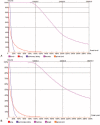125I Brachytherapy in Locally Advanced Nonsmall Cell Lung Cancer After Progression of Concurrent Radiochemotherapy
- PMID: 26656370
- PMCID: PMC5008515
- DOI: 10.1097/MD.0000000000002249
125I Brachytherapy in Locally Advanced Nonsmall Cell Lung Cancer After Progression of Concurrent Radiochemotherapy
Abstract
To investigate the safety and effectiveness of computed tomography (CT)-guided I seed implantation for locally advanced nonsmall cell lung cancer (NSCLC) after progression of concurrent radiochemotherapy (CCRT).We reviewed 78 locally advanced NSCLC patients who had each one cycle of first-line CCRT but had progressive disease identified from January 2006 to February 2015 at our institution. A total of 37 patients with 44 lesions received CT-guided percutaneous I seed implantation and second-line chemotherapy (group A), while 41 with 41 lesions received second-line chemotherapy (group B).Patients in group A and B received a total of 37 and 41 first cycle of CCRT treatment. The median follow-up was 19 (range 3-36) months. After the second treatment, the total response rate (RR) in tumor response accounted for 63.6% in group A, which was significantly higher than that of group B (41.5%) (P = 0.033). The median progression-free survival time (PFST) was 8.00 ± 1.09 months and 5.00 ± 0.64 months in groups A and B (P = 0.011). The 1-, 2-, and 3-year overall survival (OS) rates for group A were 56.8%, 16.2%, and 2.7%, respectively. For group B, OS rates were 36.6%, 9.8%, and 2.4%, respectively. The median OS time was 14.00 ± 1.82 months and 10.00 ± 1.37 months for groups A and B, respectively (P = 0.059). Similar toxicity reactions were found in both groups. Tumor-related clinical symptoms were significantly reduced and the patients' quality of life was obviously improved.CT-guided I seed implantation proved to be potentially beneficial in treating localized advanced NSCLC; it achieved good local control rates and relieved clinical symptoms without increasing side effects.
Conflict of interest statement
The authors have no conflicts of interest to disclose.
Figures






Similar articles
-
Efficacy and safety of chemotherapy combined with iodine-125 seed brachytherapy for intermediate and advanced oncogenic driver gene-negative non-small cell lung cancer.Brachytherapy. 2025 Jan-Feb;24(1):92-102. doi: 10.1016/j.brachy.2024.09.005. Epub 2024 Dec 19. Brachytherapy. 2025. PMID: 39818422
-
The Clinical Value of Computed Tomography (CT)-Guided 125I Brachytherapy for Locally Advanced Non-Small Cell Lung Cancer After Progression of Concurrent Radiochemotherapy.Cancer Manag Res. 2021 Jul 5;13:5297-5307. doi: 10.2147/CMAR.S313438. eCollection 2021. Cancer Manag Res. 2021. PMID: 34262339 Free PMC article.
-
Effectiveness and safety of CT-guided (125)I seed brachytherapy for postoperative locoregional recurrence in patients with non-small cell lung cancer.Brachytherapy. 2016 May-Jun;15(3):370-380. doi: 10.1016/j.brachy.2016.02.001. Epub 2016 Mar 2. Brachytherapy. 2016. PMID: 26944267
-
Anatomic segmentectomy and brachytherapy mesh implantation for clinical stage I non-small cell lung cancer (NSCLC).Surgery. 2014 Feb;155(2):340-6. doi: 10.1016/j.surg.2013.06.055. Epub 2013 Dec 5. Surgery. 2014. PMID: 24314884 Review.
-
Definitive radiochemotherapy versus surgery within multimodality treatment in stage III non-small cell lung cancer (NSCLC) - a cumulative meta-analysis of the randomized evidence.Oncotarget. 2017 Jun 20;8(25):41670-41678. doi: 10.18632/oncotarget.16471. Oncotarget. 2017. PMID: 28415831 Free PMC article. Review.
Cited by
-
Clinical efficacy and prognostic factors of CT-guided 125I brachytherapy for the palliative treatment of retroperitoneal metastatic lymph nodes.Cancer Imaging. 2020 Apr 6;20(1):25. doi: 10.1186/s40644-020-00299-x. Cancer Imaging. 2020. PMID: 32252826 Free PMC article.
-
CT-guided 125I brachytherapy in the treatment of distant metastases in the oral cavity and maxillofacial region.Transl Oncol. 2017 Feb;10(1):90-98. doi: 10.1016/j.tranon.2016.11.007. Epub 2016 Dec 16. Transl Oncol. 2017. PMID: 27992832 Free PMC article.
-
Success of 125I-Seed Treatment in Vulvar Squamous-Cell Carcinoma with Aplastic Anemia: A Case Report.Onco Targets Ther. 2020 Dec 7;13:12561-12566. doi: 10.2147/OTT.S283006. eCollection 2020. Onco Targets Ther. 2020. PMID: 33324074 Free PMC article.
-
CT-guided 125I brachytherapy combined with chemotherapy for the treatment of unresectable or locally advanced pancreatic carcinoma.Diagn Interv Radiol. 2021 Jan;27(1):50-58. doi: 10.5152/dir.2020.19371. Diagn Interv Radiol. 2021. PMID: 33252336 Free PMC article.
-
I-125 seeds with chemotherapy for progressive non-small-cell lung cancer after first-line treatment: a meta-analysis.J Cardiothorac Surg. 2022 Apr 12;17(1):75. doi: 10.1186/s13019-022-01820-y. J Cardiothorac Surg. 2022. PMID: 35413934 Free PMC article. Review.
References
-
- Edelman MJ, Khanwani SL. Advanced non-small cell lung cancer. Curr Treat Options Oncol 2001; 2:51–62. - PubMed
-
- Siegel R, Naishadham D, Jemal A. Cancer statistics. CA Cancer J Clin 2013; 63:11–30. - PubMed
-
- Toyokawa G, Takenoyama M, Ichinose Y. Multimodality treatment with surgery for locally advanced non-small-cell lung cancer with N2 disease: a review article. Clin Lung Cancer 2015; 16:6–14. - PubMed
-
- Cardona AF, Reveiz L, Ospina EG, et al. Palliative endobronchial brachytherapy for non-small cell lung cancer. Cochrane Database Syst Rev 2008; 2:CD004284. - PubMed
Publication types
MeSH terms
Substances
LinkOut - more resources
Full Text Sources
Medical

